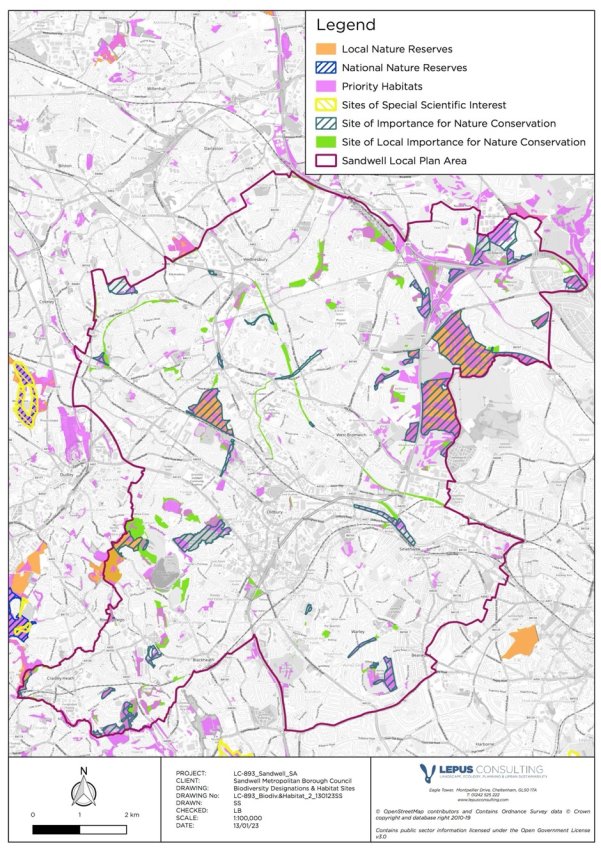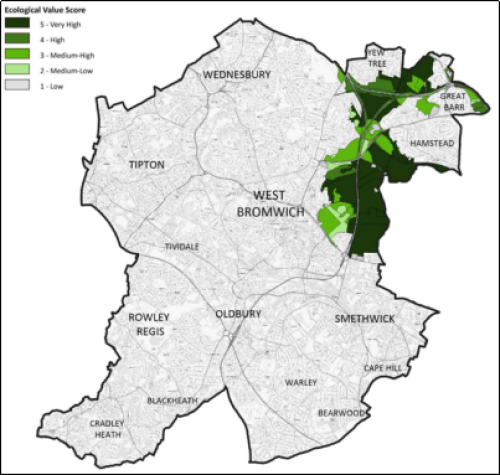Sustainability Appraisal of the Sandwell Local Plan 2024-2041
8 Biodiversity, flora and fauna
8.1 Introduction
8.1.1 The conservation of biological and geological diversity and the protection and monitoring of endangered and vulnerable species and habitats is of great importance. National and European policies identify a hierarchy of designations which aim to promote the protection and enhancement of the natural environment. Key PPPs include the 25 Year Environment Plan[61] and the Biodiversity Strategy for England[62] which seek to halt biodiversity loss, promote nature recovery, and expand multi-functional green infrastructure (GI) networks.
8.1.2 The Environment Act 2021[63] introduced targets, plans and policies for improving the natural environment. An important aspect of the Act is the focus on biodiversity net gain (BNG), and the incorporation of the Statutory Biodiversity Metric[64] into law to ensure all new development delivers 10% net gain in biodiversity. Mandatory BNG has since come into force for Town and Country Planning Act developments as of February 2024[65]. Sandwell has conducted a Biodiversity Net Gain Study[66] to inform the delivery of BNG as part of the SLP.
8.1.3 Local-level action plans for biodiversity and GI strategies should reflect these ecosystem-wide approaches and complement this with local priorities and goals to ensure that the Plan area's wildlife, ecology, geology and ecosystem services are protected and enhanced.
8.2 Baseline and key issues
European sites
8.2.1 European sites provide valuable ecological infrastructure for the protection of rare, endangered and/or vulnerable natural habitats and species of exceptional importance within the EU. These sites consist of Special Areas of Conservation (SACs) designated under the Habitats Directive, and Special Protection Areas (SPAs) classified under the Birds Directive. Additionally, paragraph 187 of the NPPF (2023) requires that sites listed under the Ramsar Convention are to be given the same protection as fully designated European sites.
8.2.2 The closest European sites to Sandwell are 'Fens Pools' SAC approximately 3km to the west and 'Cannock Extension Canal' SAC approximately 8km to the north. Threats and pressures to Fens Pools include habitat fragmentation and water pollution[67], and for Cannock Extension Canal water pollution and air pollution are key threats[68].
8.2.3 A Habitats Regulations Assessment (HRA)[69] has been prepared alongside the development of the SLP to provide an in-depth assessment of the potential threats and pressures to a number of European sites and analysis of potential impact pathways. The outputs of the HRA process have been used to inform the SA.
National and local designations
8.2.4 There are no Sites of Special Scientific Interest (SSSIs) within Sandwell. Nearby SSSIs include 'Wren's Nest' and 'The Leasowes' in Dudley. SSSI Impact Risk Zones (IRZs) within Sandwell flag larger scale industrial / commercial development as requiring consultation with Natural England such as aviation and quarrying, rather than residential development likely to be within influence of the SLP.
8.2.5 There are no National Nature Reserves (NNRs) located within the SLP area, but both 'Wren's Nest' and 'Saltwells' NNRs lie within 1km of the Sandwell boundary to the west, in Dudley.
8.2.6 Nine Local Nature Reserves (LNRs) are located within Sandwell, forming key sections of the ecological network within the SLP area in addition to the numerous Sites of Importance for Nature Conservation (SINC) and Sites of Local Importance for Nature Conservation (SLINC). This includes recent boundary amendments to some SLINCs at 'Alexandra Road', 'John's Lane', 'Land at Yew Tree' and 'Brandhall' as a result of ecology survey work conducted between 2019 and 2022, endorsed by the Local Sites Partnership. Areas of geological interest include Sandwell Valley Country Park and the Rowley Hills.
8.2.7 National and local biodiversity designations in and around Sandwell are shown on Figure 8.1.

Figure 8.1: Biodiversity sites and habitats in and around the SLP area (source: Natural England and SMBC)
Habitats and green infrastructure
8.2.8 Priority habitats found within Sandwell include deciduous woodland, coastal and floodplain grazing marsh, and good quality semi-improved grassland. Some small extents of lowland priority habitats including heathland, meadows and acid grassland can also be found. Careful consideration should be given during the plan-making process to the potential impacts on habitats and species of principle importance in accordance with the NERC Act 2006[70].
8.2.9 Ancient woodland is defined as an area that has been wooded continuously since at least 1600AD and includes 'ancient semi-natural woodland' and 'plantations on ancient woodland sites', both of which have equal protection under the NPPF[71]. There are very few areas of ancient woodland within the SLP area.
8.2.10 Sandwell contains a relatively small area of Green Belt land; however, it supports a high level of ecological value[72] with opportunities for implementing the Nature Recovery Network (see Figure 8.2). Multi-functional GI assets including natural and semi-natural features within the urban areas should also be conserved and enhanced to support ecosystem services and nature recovery.

Figure 8.2: The Ecological Value Score of Sandwell's Green Belt[73]
Key issues for biodiversity, flora and fauna include:
- Growth promoted within the emerging SLP is likely to put pressure on biodiversity resources. There are potential impacts such as habitat fragmentation resulting from new development areas and recreational pressures on wildlife sites.
- A number of European sites, which are sensitive to changes in air quality, may be affected by changes in traffic generated by the SLP growth alone and in-combination with other plans and projects. The HRA of the SLP alongside a review of traffic modelling data will explore these potential effects in detail.
- The SLP area is hydrologically connected to the Severn and the Humber Estuaries and their associated biodiversity designations. Habitats at these sites and migratory species of fish which use the wider catchment for phases of their lifecycle are sensitive to changes in water supply and quality which may be influenced by development proposals within the SLP. The HRA of the SLP will explore these potential effects in detail.
- Careful consideration should be given during the plan-making process to the potential impacts on habitats and species of principle importance. The remaining areas of priority habitats within Sandwell should be protected from development and enhanced where possible.
- There is a need to establish a coordinated and comprehensive GI network providing connectivity between biodiversity sites, green spaces, watercourses and other environmental features across the SLP area and wider Black Country.
- Sandwell Valley supports a high level of ecological value, which may be lost or degraded as pressure increases for new development.
Key issues relating to areas designated pursuant to Directives 79/409/EEC and 92/43/EEC (the Birds and Habitats Directives)
- The following vulnerabilities have been identified in the HRA screening process alongside the Local Plan preparation:
- Water quality and quantity issues (Fens Pools SAC, River Mease SAC, Ensor's Pool SAC, Humber Estuary SAC, SPA and Ramsar, Severn Estuary SAC, SPA and Ramsar and Cannock Extension Canal SAC); and
- Air quality (Fens Pools SAC and Cannock Extension Canal SAC).
- The Publication Draft HRA (2024) includes an appropriate assessment which was undertaken to assess these identified likely significant effects more precisely in the context of European site conservation objectives, and the protective framework provided by the emerging Local Plan policies, alongside existing planning policy frameworks.
- Taking into consideration these factors, the HRA concluded that the SLP would have no adverse impact on site integrity at any European site, either alone or in-combination.
8.3 Impacts on biodiversity, flora and fauna
8.3.1 Box 8.1 presents a plan-wide summary of the adverse impacts on biodiversity, flora and fauna that have been identified through the SA process. These adverse impacts are those identified prior to mitigation considerations.
Box 8.1: Summary of identified impacts on biodiversity, flora and fauna
Impact on biodiversity
Summary of identified impact

Threats or pressures to European sites
A number of likely significant effects (LSEs) have been identified in the HRA screening process with regard to several European sites as described in section 8.2; this includes adverse effects across a number of impact pathways including regarding air quality, and water quality and quantity.

Threats or pressures to locally designated and non-statutory biodiversity sites
Adverse impacts on locally designated sites arising due to development proposed in the SLP could potentially include direct impacts on habitats and / or indirect impacts such as increased recreational disturbance caused by local residents visiting these sites.
Six allocated sites have been identified as having potential to result in adverse impacts on LNRs, including site SH43 where a small proportion coincides with 'Forge Mill Lake', sites SEC3-26 and SH13 which are located in close proximity to 'Saltwells' and 'Mousesweet Brook', and sites SH5, SH35 and SEC1-1 which are located in close proximity to 'Sheepwash'.
Three allocated sites have been identified as having potential to result in adverse impacts on SINCs, including site SH43 where a small proportion coincides with 'Forge Mill, Sandwell Valley', site SH21 which lies adjacent to 'Gower Branch Canal' and site SH30 which lies adjacent to 'Ridgeacre Branch Canal'.
Some 23 allocated sites have been identified as having potential to result in adverse impacts on SLINCs. Nine sites coincide with SLINCs such as sites SH9 and SH18 where these sites wholly encompass 'Friar Park', where the remaining 14 sites are also located adjacent to SLINCs.

Fragmentation of the ecological network and priority habitats
Over half of all allocated sites are located on previously undeveloped land or land with environmental value, which is likely to result in the loss of soil resources and the ecosystem services they provide. Whilst in many cases these habitats can be conserved alongside development, it is likely that in some cases of fragmentation or loss of habitats and connections between habitats will occur. High levels of development and increased density within the urban area of Sandwell may also result in losses to the GI network, where it is important to retain ecological links amongst built form.
In addition, priority habitats support a range of species of principal importance. Some 12 allocated sites partially/wholly coincide with priority habitats covering 8% of the total cumulative site allocation area, including deciduous woodland and good quality semi-improved grassland.
Potential impacts associated with loss of habitats include:
- Direct effects: Permanent loss of priority habitat in short term.
- Secondary effects: Such as reduced habitat connectivity and increased fragmentation, with increased fragility of habitats.
- Indirect effects: Reduced ecological coherence.
8.4 Local Plan mitigation
8.4.1 Several policies within the SLP aim to protect and enhance biodiversity within the borough. The policies discussed in Box 8.2 are expected to provide effective protection for biodiversity assets, and are therefore likely to mitigate some of the adverse impacts identified in Box 8.1.
Box 8.2: Mitigating effects of the Local Plan policies on biodiversity, flora and fauna
Policy mitigation for biodiversity
Summary of mitigating effect

Threats or pressures to European sites
Policy SNE1: Nature conservation ensures development will not be permitted where this has potential to result in an adverse impact on an internationally designated site, including the Fens Pools SAC and the Cannock Chase SAC.
An HRA has been prepared to identify any likely significant effects as a consequence of the emerging Local Plan on European sites within the influence of the SLP. The nature of effects and the mitigation of those effects are evaluated in the emerging HRA.
Threats or pressures to locally designated and non-statutory biodiversity sites, priority habitats and species
Policy SNE1: Nature Conservation seeks to protect, conserve and enhance biodiversity assets including local designations. Where the benefits of development strategically outweigh the importance of a local nature conservation site, "damage must be minimised" and remaining impacts must be fully mitigated with an accompanying mitigation strategy.
Policy SNE2: Protection and enhancement of wildlife habitats supports the provision and enhancement of priority habitats as part of the implementation of biodiversity net gain.
Fragmentation of the ecological network and priority habitats
Policy SNE1: Nature Conservation states that development proposals will need to take account of the Local Nature Recovery Strategy and "should plan for the maintenance and where possible enhancement of such linkages". This is supported by Policy SNE2: Protection and enhancement of wildlife habitats, which lays out the foundations for implementing the Local Nature Recovery Strategy and BNG, as well as integrating local opportunities for habitats to thrive amongst new development.
Policy SNE3: Provision, retention and protection of trees, woodlands and hedgerows aims to utilise these biodiversity features for habitat creation and the restoration of ecological networks. This is supported by Policy SDS8: Green and Blue Infrastructure in Sandwell, Policy SNE5: The Rowley Hills and Policy SNE6: Canals, all of which seek to improve habitat creation and enhancement in the Plan area.
8.5 Residual effects on biodiversity, flora and fauna
8.5.1 Drawing on the information presented in Boxes 8.1 and 8.2, Box 8.3 explores the nature of the residual effects and, where applicable, provides further recommendations for mitigation or enhancement of biodiversity, flora and fauna in Sandwell.
Box 8.3: Residual effects for biodiversity, flora and fauna
Residual effects
Further details of the residual effect
Threats or pressures to European sites
Drawing on the protective framework provided by the SLP, and existing protection measures set out in existing planning policy frameworks that serve to help overcome the identified potential adverse effect, the HRA Appropriate Assessment concluded that the SLP will have no adverse impact on site integrity at any European site, either alone or in-combination.
Threats or pressures to locally designated and non-statutory biodiversity sites
The SLP policies regarding biodiversity are not likely to fully mitigate potential adverse impacts on LNRs, SINCs and SLINCs situated in proximity to the proposed development. Although these will ensure locally designated and non-statutory biodiversity assets are protected, conserved and enhanced wherever possible, not all remaining impacts are fully mitigated. As a result, there is potential for residual impacts on locally designated or non-statutory biodiversity sites, including habitat loss and recreational impacts. These will require further conservation and enhancement of biodiversity assets and improvements to the wider GI network.
Threats and pressures on locally designated and non-statutory biodiversity sites is expected to be a long-term and permanent significant effect.
Fragmentation of the ecological network and priority habitats
Despite BNG provisions at the site level, there remains potential for cumulative adverse impacts on biodiversity at the landscape scale, or where the majority of a site coincides with a priority habitat such as where SEC3-193 coincides with deciduous woodland. Incremental habitat losses will be likely as a result of construction resulting from the SLP on undeveloped land which will include the loss of soil resources. Ecological links between biodiversity assets are unlikely to be protected, whereby the policies will not be expected to fully mitigate the fragmentation of the ecological network.
Fragmentation of the ecological network and loss of priority habitats across Sandwell is expected to be a long-term and permanent significant effect.
[61] HM Government (2018) A Green Future: Our 25 Year Plan to Improve the Environment. Available at: https://assets.publishing.service.gov.uk/government/uploads/system/uploads/attachment_data/file/693158/25-year-environment-plan.pdf [Date accessed: 04/07/24]
[62]Department for Environment, Food & Rural Affairs (2011) Biodiversity 2020: A strategy for England's wildlife and ecosystem services. Available at: https://www.gov.uk/government/publications/biodiversity-2020-a-strategy-for-england-s-wildlife-and-ecosystem-services [Date accessed: 04/07/24]
[63] Environment Act 2021. Available at: https://www.legislation.gov.uk/ukpga/2021/30/contents/enacted [Date accessed: 04/07/24]
[64] HM Government (2024) Statutory biodiversity metric. Available at: https://www.gov.uk/government/publications/statutory-biodiversity-metric-tools-and-guides [Date accessed: 04/07/24]
[65] Natural England (2022) Get ready for the new Biodiversity Net Gain legislation. Available at: https://naturalengland.blog.gov.uk/2024/02/12/get-ready-for-new-biodiversity-net-gain-legislation/ [Date accessed: 04/07/24]
[66] Lepus Consulting (2023) Biodiversity Net Gain Study. Available at: https://www.sandwell.gov.uk/downloads/file/1553/sandwell-biodiversity-net-gain-bng-strategy-september-2023- [Date accessed: 08/07/24]
[67] Natural England (2014) Site Improvement Plan: Fens Pools. Available at: http://publications.naturalengland.org.uk/file/4872756676001792 [Date accessed: 04/07/24]
[68] Natural England (2014) Site Improvement Plan: Cannock Extension Canal. Available at: http://publications.naturalengland.org.uk/file/6749431462363136 [Date accessed: 04/07/24]
[69] Lepus Consulting (2024) Sandwell Local Plan Regulation 19: Habitats Regulations Assessment.
[70]Natural Environment and Rural Communities Act 2006. Available at: http://www.legislation.gov.uk/ukpga/2006/16/contents [Date accessed: 04/07/24]
[71]Forestry Commission and Natural England (2022) Ancient woodland, ancient trees and veteran trees: protecting them from development. Available at: https://www.gov.uk/guidance/ancient-woodland-and-veteran-trees-protection-surveys-licences [Date accessed: 04/07/24]
[72] EcoRecord (2019) An Ecological Evaluation of the Black Country Green Belt, October 2019. Available at: https://blackcountryplan.dudley.gov.uk/media/13896/an-ecological-evaluation-of-the-black-country-green-belt-final-report-2019-redacted.pdf [Date accessed: 04/07/24]
[73] Ibid.
